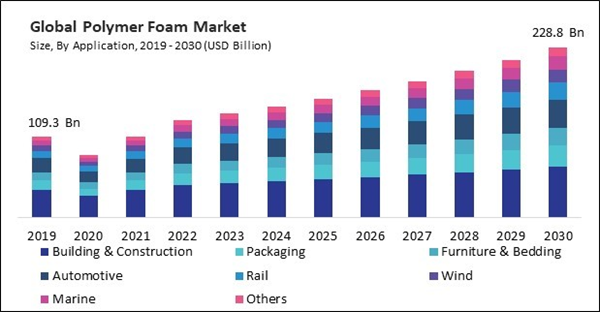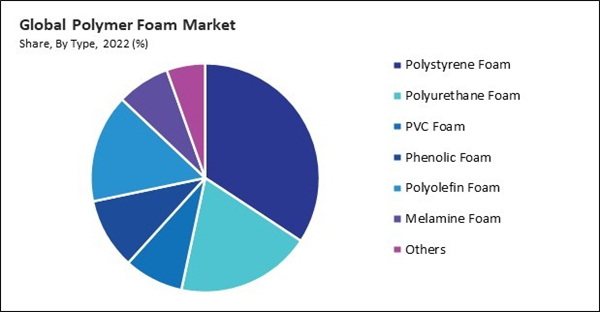The Global Polymer Foam Market size is expected to reach $228.8 billion by 2030, rising at a market growth of 7.3% CAGR during the forecast period. In the year 2022, the market attained a volume of 55,371.9 million square meter, experiencing a growth of 6.7% (2019-2022).
Phenolic foam is renowned for its exceptional fire performance characteristics. Thus, the phenolic foam segment acquired $13,112.3 million in 2022. Also, the US market would utilize 1,059.1 million square meter of Phenolic foam by 2030. Phenolic foam is often used in building and construction applications, such as insulation for walls, roofs, and ceilings, where compliance with fire regulations is essential.
Polymer foams, such as expanded polystyrene (EPS) and polyurethane (PU) foam, are widely used as insulation materials in construction and infrastructure projects. Due to their superior thermal insulation qualities, these foams can assist in lowering energy costs and raise the general energy efficiency of industrial, commercial, and residential buildings. In conclusion, growing construction and increasing infrastructure development propel the market’s growth.
Additionally, Continuous material science research and development efforts have created polymer foams with improved qualities like durability, strength, thermal stability, and flexibility. These advancements allow polymer foams to meet various application requirements across various industries, including automotive, construction, packaging, and electronics. In conclusion, advancements in material science and manufacturing technologies are propelling the market’s growth.
However, Polymer foam production heavily relies on raw materials like petrochemicals, resins, and other chemicals. Price fluctuations for these raw materials greatly affect the overall cost of polymer foam production. Therefore, volatility in raw material prices is hampering the market’s growth.
Phenolic foam is renowned for its exceptional fire performance characteristics. Thus, the phenolic foam segment acquired $13,112.3 million in 2022. Also, the US market would utilize 1,059.1 million square meter of Phenolic foam by 2030. Phenolic foam is often used in building and construction applications, such as insulation for walls, roofs, and ceilings, where compliance with fire regulations is essential.
Polymer foams, such as expanded polystyrene (EPS) and polyurethane (PU) foam, are widely used as insulation materials in construction and infrastructure projects. Due to their superior thermal insulation qualities, these foams can assist in lowering energy costs and raise the general energy efficiency of industrial, commercial, and residential buildings. In conclusion, growing construction and increasing infrastructure development propel the market’s growth.
Additionally, Continuous material science research and development efforts have created polymer foams with improved qualities like durability, strength, thermal stability, and flexibility. These advancements allow polymer foams to meet various application requirements across various industries, including automotive, construction, packaging, and electronics. In conclusion, advancements in material science and manufacturing technologies are propelling the market’s growth.
However, Polymer foam production heavily relies on raw materials like petrochemicals, resins, and other chemicals. Price fluctuations for these raw materials greatly affect the overall cost of polymer foam production. Therefore, volatility in raw material prices is hampering the market’s growth.
By Type Analysis
Based on type, the market is divided into polyurethane foam, polystyrene foam, PVC foam, phenolic foam, polyolefin foam, melamine foam, and others. The polyurethane foam segment attained a noteworthy 19% revenue share in the market in 2022. In terms of volume, the polyurethane foam segment would utilize 7,249.9 million square meter of polymer foam by 2030. Polyurethane (PU) foam is employed in medical and healthcare applications for patient positioning, support surfaces, orthopedic devices, and wound care products.By Application Analysis
Based on application, the market is categorized into packaging, building & construction, furniture & bedding, automotive, rail, wind, marine, and others. In 2022, the building & construction segment registered 34% revenue share in the market. In terms of volume, the building & construction segment would utilize 32,219.8 million square meter of polymer foam by 2030. Polymer foams are versatile materials that can be molded, shaped, and fabricated into various forms, sizes, and configurations to suit specific building and construction needs.By Regional Analysis
Region-wise, the market is analyzed across North America, Europe, Asia Pacific, and LAMEA. In 2022, the Asia Pacific region witnessed a 40% revenue share in the market. In terms of volume, the Asia Pacific region would utilize 49,872.8 million square meter of polymer foam by 2030.List of Key Companies Profiled
- Arkema S.A.
- BASF SE
- Borealis AG (OMV)
- Synthos S.A. (FTF Galleon S.A.)
- DuPont de Nemours, Inc.
- Trelleborg AB
- Zotefoams plc
- Sealed Air Corporation
- Woodbridge Foam Corporation
- Polymer Technologies, Inc.
Market Report Segmentation
By Type (Volume, Million Square Meter, USD Billion, 2019-2030)- Polystyrene Foam
- Polyurethane Foam
- PVC Foam
- Phenolic Foam
- Polyolefin Foam
- Melamine Foam
- Others
- Building & Construction
- Packaging
- Furniture & Bedding
- Automotive
- Rail
- Wind
- Marine
- Others
- North America
- US
- Canada
- Mexico
- Rest of North America
- Europe
- Germany
- UK
- France
- Russia
- Spain
- Italy
- Rest of Europe
- Asia Pacific
- China
- Japan
- India
- South Korea
- Singapore
- Malaysia
- Rest of Asia Pacific
- LAMEA
- Brazil
- Argentina
- UAE
- Saudi Arabia
- South Africa
- Nigeria
- Rest of LAMEA
Table of Contents
Chapter 1. Market Scope & Methodology
Chapter 2. Market at a Glance
Chapter 3. Market Overview
Chapter 4. Global Polymer Foam Market by Type
Chapter 5. Global Polymer Foam Market by Application
Chapter 6. Global Polymer Foam Market by Region
Chapter 7. Company Profiles
Companies Mentioned
- Arkema S.A.
- BASF SE
- Borealis AG (OMV)
- Synthos S.A. (FTF Galleon S.A.)
- DuPont de Nemours, Inc.
- Trelleborg AB
- Zotefoams plc
- Sealed Air Corporation
- Woodbridge Foam Corporation
- Polymer Technologies, Inc.
Methodology

LOADING...










